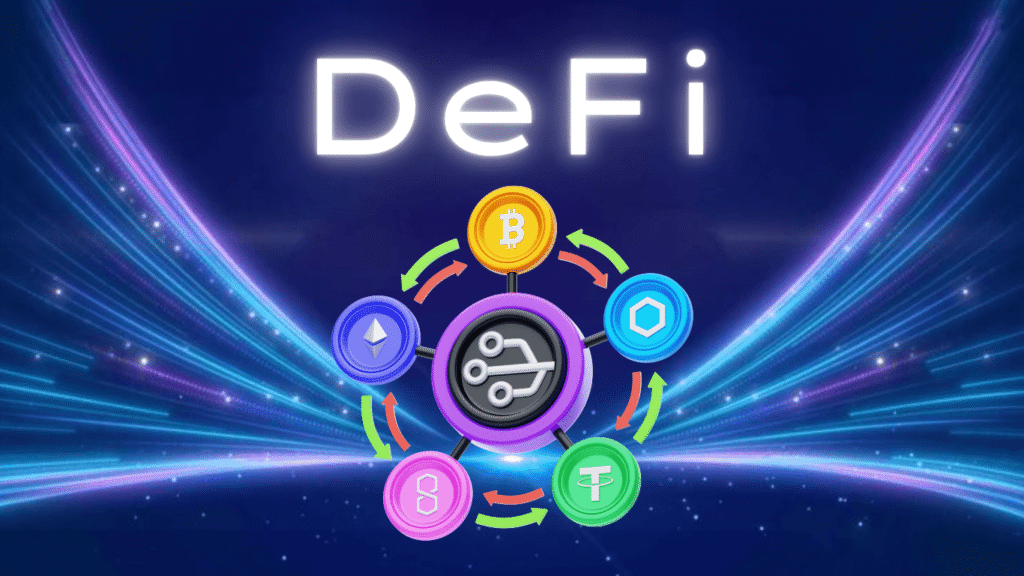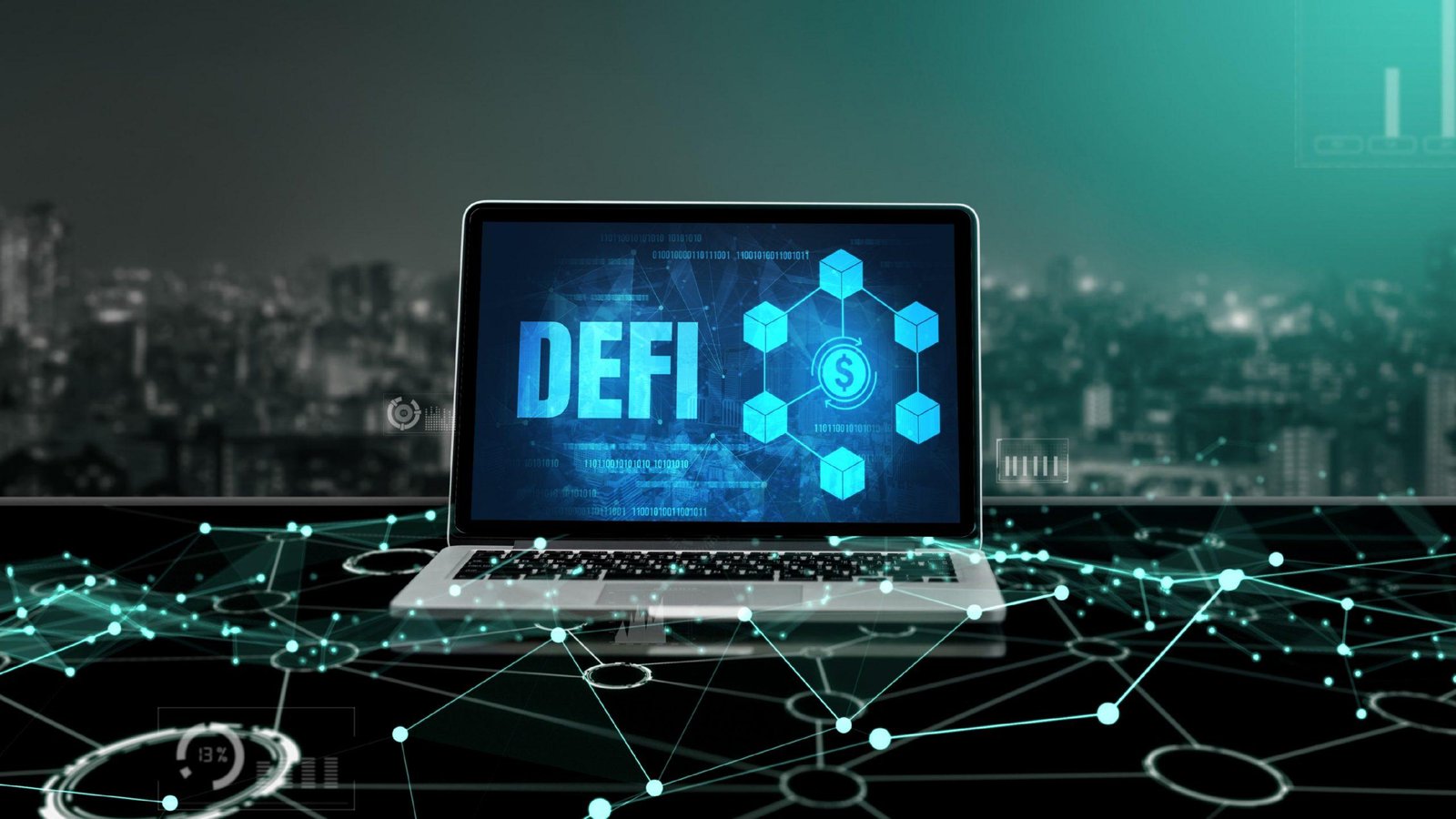Decentralised finance (DeFi) positions itself to fundamentally challenge the dominance of traditional finance (TradFi). According to a groundbreaking forecast from Standard Chartered, one of the world’s leading international banking groups, the tokenised assets market is projected to reach an astounding $2 trillion by 2028. This prediction signals not just incremental growth but a transformative revolution that could redefine how individuals, institutions, and governments interact with financial services.
The convergence of blockchain technology, regulatory clarity, and institutional adoption is creating the perfect storm for digital asset transformation.DeFi vs TradFi $2T Tokenized: As we stand at this critical juncture, understanding the implications of this shift becomes essential for investors, financial professionals, and anyone interested in the future of money. The rise of tokenised real-world assets (RWAs), combined with the maturing infrastructure of decentralised protocols, suggests that the barrier between DeFi and TradFi is becoming increasingly permeable.
This comprehensive analysis explores DeFi vs TradFi $2T Tokenised Standard Chartered’s bold projection, examining the catalysts driving this growth, the challenges that lie ahead, and what this paradigm shift means for the global financial ecosystem. From tokenised securities to decentralised lending platforms, we’ll uncover how blockchain-based finance is not just competing with traditional systems but potentially offering superior alternatives in terms of efficiency, accessibility, and transparency.
DeFi Revolution and Its Impact on Traditional Finance
Decentralised finance represents a fundamental reimagining of financial infrastructure, removing intermediaries and replacing them with smart contracts and blockchain protocols. Unlike TradFi, which relies on centralised institutions like banks, clearinghouses, and exchanges, DeFi operates on transparent, permissionless networks that anyone with an internet connection can access. This democratisation of finance has already captured significant value, with the total value locked (TVL) in DeFi protocols exceeding hundreds of billions of dollars at various points.
The core premise of DeFi challenges centuries-old financial conventions by enabling peer-to-peer transactions, automated market making, and programmable money without requiring trust in centralised authorities. Smart contracts—self-executing agreements written in code—facilitate everything from lending and borrowing to complex derivatives trading. This technological foundation eliminates many inefficiencies inherent in traditional systems, including settlement delays, high transaction costs, and limited operating hours.
Standard Chartered’s projection of $2 trillion in tokenised assets by 2025 reflects growing confidence that institutional capital will increasingly flow into blockchain-based financial instruments. Major financial institutions, once sceptical of cryptocurrency and DeFi, are now actively exploring tokenisation opportunities. Banks worldwide are piloting projects involving tokenised bonds, real estate, commodities, and even carbon credits, recognising that blockchain technology offers substantial operational advantages.
The distinction between DeFi and TradFi is also becoming less binary as hybrid models emerge. These systems leverage blockchain’s transparency and efficiency while incorporating regulatory compliance and traditional finance’s risk management frameworks. This convergence suggests that rather than complete replacement, we’re likely witnessing the evolution of financial infrastructure where both paradigms coexist and complement each other.
The Tokenisation Phenomenon: Converting Real-World Assets to Digital Form
Asset tokenisation stands as the cornerstone of Standard Chartered’s ambitious forecast, representing the process of converting ownership rights in real-world assets into digital tokens on a blockchain. This transformation enables fractional ownership, instantaneous settlement, and 24/7 trading of traditionally illiquid assets. From real estate and fine art to government bonds and private equity stakes, virtually any asset class can be tokenised, creating unprecedented liquidity and accessibility.
The mechanics of tokenisation involve creating digital representations of assets that are recorded on distributed ledgers, ensuring immutability and transparent ownership history. These digital tokens can be transferred, traded, or collateralised much more efficiently than their physical or traditional electronic counterparts. For instance, instead of waiting days for a real estate transaction to settle through multiple intermediaries, tokenised property shares could theoretically change hands in minutes with significantly reduced costs.
Financial institutions are particularly excited about tokenising securities, a process that could revolutionise capital markets. Tokenised bonds and stocks eliminate many pain points in traditional securities trading, including T+2 settlement cycles, reconciliation errors, and geographical restrictions. BlackRock, Franklin Templeton, and other asset management giants have already launched tokenised funds, demonstrating institutional commitment to this technology.
Beyond securities, the tokenisation of real-world assets like commodities, invoices, and supply chain receipts creates new opportunities for financing and investment. Small businesses could tokenise their accounts receivable to access immediate liquidity, while investors gain exposure to previously inaccessible asset classes. This expansion of investable opportunities democratizes wealth creation and could significantly enhance capital efficiency across global markets.
Standard Chartered’s $2 trillion projection appears conservative when considering that global real estate alone represents over $300 trillion in value. Even capturing a small percentage of traditional asset classes through tokenisation would generate massive volumes. As regulatory frameworks mature and technological infrastructure improves, the pace of tokenisation is expected to accelerate dramatically through 2028 and beyond.
Institutional Adoption: Banks and Corporations Embrace Blockchain Technology
The institutional embrace of blockchain technology marks a critical inflection point in the DeFi versus TradFi narrative. Standard Chartered itself exemplifies this shift, having invested heavily in blockchain research and pilot programs. The bank’s involvement in tokenisation projects, cross-border payment solutions, and central bank digital currency (CBDC) explorations demonstrates how traditional financial institutions are positioning themselves for a digital future.
Major global banks, including JPMorgan, HSBC, and Citigroup, have established dedicated digital asset divisions, hired blockchain specialists, and participated in industry consortia developing tokenisation standards. JPMorgan’s Onyx platform has already processed over $300 billion in intraday repo transactions using blockchain technology, proving that distributed ledger technology can handle institutional-scale volumes while delivering tangible efficiency gains.
Corporate treasuries are also increasingly comfortable holding and transacting in digital assets. Companies are exploring tokenised commercial paper, blockchain-based supply chain finance, and cryptocurrency treasury management. This corporate adoption provides additional momentum for DeFi growth, creating natural demand for tokenised assets and decentralised financial services that offer better yields, faster settlement, and global accessibility compared to traditional banking products.
Regulatory engagement represents another crucial factor in institutional adoption. Rather than prohibiting digital assets, leading financial regulators are developing comprehensive frameworks to safely integrate blockchain technology into existing financial infrastructure. The European Union’s Markets in Crypto-Assets (MiCA) regulation, Singapore’s progressive digital asset licensing regime, and ongoing regulatory developments in other major jurisdictions are providing the clarity institutions need to commit substantial resources to DeFi and tokenisation.
Insurance companies and pension funds, traditionally the most conservative institutional investors, are beginning to allocate to tokenised assets and DeFi protocols. This capital represents trillions of dollars that could flow into blockchain-based financial systems once appropriate risk management frameworks are established. Standard Chartered’s projection likely factors in this gradual but significant institutional migration toward digital assets.
Technological Infrastructure: Building the Rails for DeFi Growth
The technological maturation of blockchain networks provides essential infrastructure for Standard Chartered’s projected growth. Ethereum, the dominant platform for DeFi applications, has undergone significant upgrades improving scalability, security, and energy efficiency. Layer-2 solutions like Arbitrum, Optimism, and Polygon further enhance transaction throughput while reducing costs, making DeFi applications practical for mainstream adoption.
Interoperability solutions are connecting previously isolated blockchain ecosystems, enabling seamless asset transfers and communication between different networks. Cross-chain bridges, wrapped tokens, and interoperability protocols ensure that tokenised assets can move freely across platforms, maximising liquidity and utility. This interconnectedness mirrors the global nature of traditional finance while maintaining decentralisation’s benefits.
Custody solutions tailored for institutional requirements have emerged as critical infrastructure components. Regulated custodians like Coinbase Custody, BitGo, and Anchorage Digital provide the security and insurance that institutions demand when holding digital assets. These services bridge the gap between DeFi’s innovative capabilities and TradFi’s risk management standards, enabling larger capital allocations.
Smart contract security has improved dramatically through formal verification methods, extensive auditing practices, and bug bounty programs. While vulnerabilities still occasionally emerge, the DeFi ecosystem has become significantly more robust than in its early years. Insurance protocols specifically designed to protect against smart contract failures provide additional safety nets, making DeFi participation more palatable for risk-averse institutional investors.
Oracle networks that feed real-world data into blockchain systems have also matured, enabling more sophisticated DeFi applications. Chainlink, Band Protocol, and other oracle solutions allow smart contracts to interact with off-chain information, facilitating complex financial instruments that depend on external data sources. This capability is essential for tokenised assets tied to real-world prices, valuations, and conditions.
Challenges and Obstacles Facing DeFi’s Path to $2 Trillion
Despite the optimistic projections, significant challenges could impede DeFi’s growth trajectory toward $2 trillion in tokenised assets. Regulatory uncertainty remains the most substantial obstacle, as governments worldwide grapple with how to oversee decentralised systems that fundamentally resist traditional regulatory approaches. Conflicting jurisdictional requirements could fragment the market, reducing efficiency and limiting growth potential.
Security vulnerabilities continue to plague the DeFi ecosystem, with billions lost annually to hacks, exploits, and protocol failures. High-profile incidents damage confidence and deter both retail and institutional participation. Until blockchain security reaches levels comparable to traditional banking systems, widespread adoption will remain constrained. The irreversible nature of blockchain transactions amplifies the consequences of security breaches, making robust protection mechanisms non-negotiable.
Scalability limitations persist despite technological improvements. During periods of high network activity, transaction costs on major blockchains can spike dramatically, making DeFi applications prohibitively expensive for smaller users. While layer-2 solutions offer relief, they introduce additional complexity and potential security considerations. Achieving truly global scale while maintaining decentralisation remains an ongoing technical challenge.
User experience barriers prevent mainstream adoption of DeFi platforms. Managing private keys, understanding gas fees, navigating multiple protocols, and assessing smart contract risks requires technical sophistication that average users lack. Until interfaces become as intuitive as traditional banking apps, DeFi will struggle to achieve mass-market penetration beyond crypto-native users and financially sophisticated individuals.
Market volatility inherent in digital assets creates challenges for the tokenisation of stable-value real-world assets. While stablecoins provide one solution, their regulatory status remains uncertain in many jurisdictions. Developing reliable mechanisms to maintain peg stability for tokenised traditional assets without reintroducing centralisation represents an ongoing design challenge for the ecosystem.
The Hybrid Future: Integration Rather Than Replacement
Rather than complete displacement, the most likely scenario involves DeFi and TradFi integration, creating a hybrid financial ecosystem that leverages the strengths of both paradigms. Traditional banks increasingly offer cryptocurrency custody, tokenised securities, and blockchain-based services while DeFi protocols incorporate compliance features, identity verification, and institutional-grade risk management.
This convergence is already visible in central bank digital currencies (CBDCs), which utilise blockchain technology within centralised monetary policy frameworks. Over 100 countries are exploring or piloting CBDCs, representing a middle ground between fully decentralised cryptocurrencies and traditional fiat systems. These government-backed digital currencies could serve as bridges between TradFi and DeFi, facilitating seamless value transfer across systems.
Permissioned blockchain networks designed specifically for institutional use exemplify this hybrid approach. Platforms like R3’s Corda and Digital Asset’s DAML provide blockchain benefits—transparency, efficiency, programmability—while maintaining the control and privacy that regulated institutions require. These systems enable tokenisation and smart contract functionality without sacrificing regulatory compliance or operational governance.
Decentralised autonomous organisations (DAOs) are evolving to incorporate legal structures that allow them to interact with traditional systems while preserving decentralised governance principles. This legal-technical hybrid enables DAOs to own real-world assets, enter into contracts, and comply with regulations without completely abandoning their decentralised ethos. Such innovations facilitate the tokenisation of traditional assets within DeFi frameworks.
Standard Chartered’s projection likely assumes this integration model, where tokenised assets flow between traditional and decentralised systems based on efficiency, regulatory requirements, and user preferences. Rather than a winner-take-all scenario, the financial future appears to be one of coexistence, with specialised use cases determining which system serves particular needs most effectively.
Investment Opportunities: DeFi vs TradFi $2T Tokenized
The projected growth to $2 trillion in tokenised assets creates substantial investment opportunities across multiple sectors. Blockchain infrastructure providers building the technological foundation for tokenisation represent one avenue, with companies developing custody solutions, oracle networks, and scaling technologies positioned to capture significant value as adoption accelerates.
Tokenised real estate platforms offer investors fractional ownership opportunities previously accessible only to ultra-high-net-worth individuals. These platforms democratize access to premium properties, providing liquidity in traditionally illiquid markets. As tokenisation standards mature and regulations clarify, this sector could experience explosive growth, particularly in international markets where property ownership faces significant barriers.
Decentralised exchanges and automated market makers that facilitate trading of tokenised assets represent another investment category. Platforms like Uniswap, Curve, and their institutional-focused equivalents capture fees from increasing trading volumes as tokenised assets proliferate. Companies developing compliant, user-friendly interfaces for these systems could achieve significant market share.
Asset management firms creating tokenised fund products position themselves at the intersection of TradFi capital and DeFi innovation. Traditional investment firms that successfully tokenise their offerings gain operational efficiencies while attracting crypto-native capital, potentially outperforming competitors still reliant on legacy infrastructure.
Investing in the underlying blockchain networks themselves through native tokens offers exposure to the entire ecosystem’s growth. DeFi vs TradFi $2T Tokenized: Ethereum, with its dominant position in DeFi and tokenisation, represents the most established option, while newer platforms promising superior scalability or specialised features provide higher-risk, higher-reward alternatives. Diversified exposure through cryptocurrency index products or blockchain-focused ETFs offers more conservative participation in this growth trend.
Conclusion
Standard Chartered’s projection that DeFi will challenge TradFi with $2 trillion in tokenised assets by 2025 represents more than optimistic forecasting—it reflects fundamental shifts already underway in global finance. DeFi vs TradFi $2T Tokenized: The convergence of technological maturity, regulatory evolution, and institutional adoption creates conditions for unprecedented growth in blockchain-based financial systems. While challenges around security, scalability, and user experience remain, the trajectory clearly points toward increasing integration of decentralised and traditional finance.
The tokenisation revolution promises to unlock trillions in previously illiquid value, democratize investment access, and dramatically improve financial system efficiency. DeFi vs TradFi $2T Tokenized: Rather than a complete replacement, we’re witnessing the birth of a hybrid ecosystem where blockchain technology enhances traditional finance while DeFi protocols offer innovative alternatives. DeFi vs TradFi $2T Tokenized: Investors, institutions, DeFi vs TradFi $2T Tokenized: and individuals who understand and position themselves for this transition stand to benefit substantially.
As we approach 2028, the distinction between DeFi and TradFi will likely blur further, with tokenised assets flowing seamlessly between systems based on efficiency and user needs. DeFi vs TradFi $2T Tokenized: Standard Chartered’s bold prediction may ultimately prove conservative if adoption accelerates beyond current projections. DeFi vs TradFi $2T Tokenized: The financial revolution is not coming—it’s already here, transforming how we create, transfer, and store value in the digital age.
FAQs
Q: What are tokenised assets, and how do they differ from traditional financial instruments?
Tokenised assets are digital representations of real-world assets recorded on blockchain networks, enabling fractional ownership, instant settlement, and 24/7 trading. DeFi vs TradFi $2T Tokenized: Unlike traditional financial instruments that require intermediaries for transfer and settlement, tokenised assets utilise smart contracts to automate processes, reducing costs and settlement times from days to minutes.
Q: How will DeFi reaching $2 trillion in tokenised assets impact everyday consumers?
As DeFi grows and tokenisation becomes mainstream, everyday consumers will gain access to investment opportunities previously reserved for wealthy individuals and institutions. DeFi vs TradFi $2T Tokenized: Fractional ownership of premium real estate, fine art, and other high-value assets will become accessible with minimal capital requirements.
Q: What are the main risks associated with investing in tokenised assets and DeFi?
Primary risks include smart contract vulnerabilities that could lead to loss of funds, regulatory uncertainty that might impact asset values or accessibility, DeFi vs TradFi $2T Tokenized: market volatility, particularly affecting crypto-denominated investments, and technological complexity that increases user error risk.
Q: How are traditional financial institutions like Standard Chartered adapting to the DeFi revolution?
Traditional banks are establishing dedicated blockchain divisions, investing in tokenisation infrastructure, and forming partnerships with DeFi vs TradFi $2T Tokenized: DeFi protocols and blockchain platforms. Institutions like Standard Chartered are piloting tokenized securities offerings, exploring central bank digital currencies, and developing custody solutions for digital assets.
Q: Will DeFi completely replace traditional banking by 2025, or will they coexist?
Complete replacement is highly unlikely by 2028. Instead, experts anticipate increasing integration where both systems coexist and complement each other. DeFi vs TradFi $2T Tokenized: Traditional banks will incorporate blockchain technology and tokenisation while maintaining regulatory compliance and risk management frameworks, while DeFi protocols will add compliance features and institutional-grade infrastructure.



